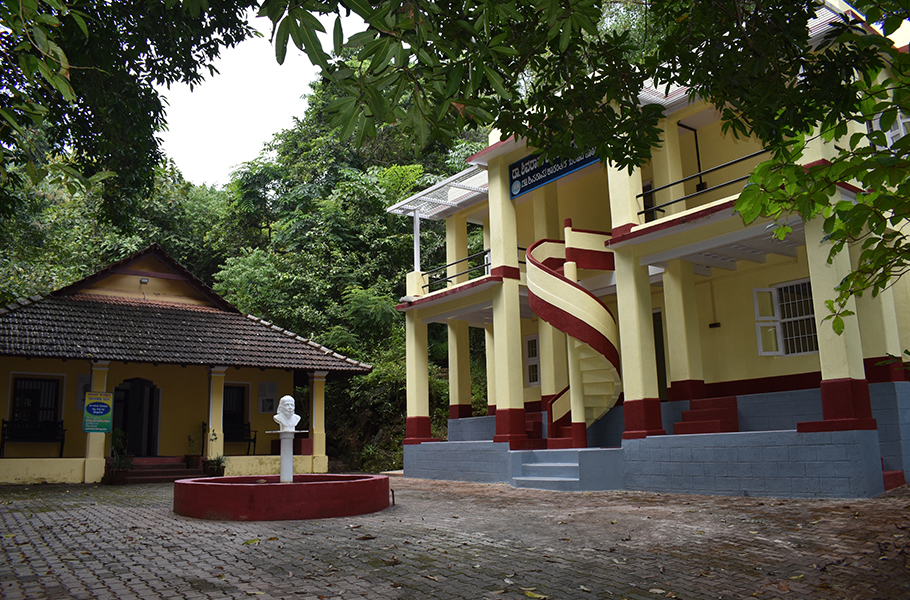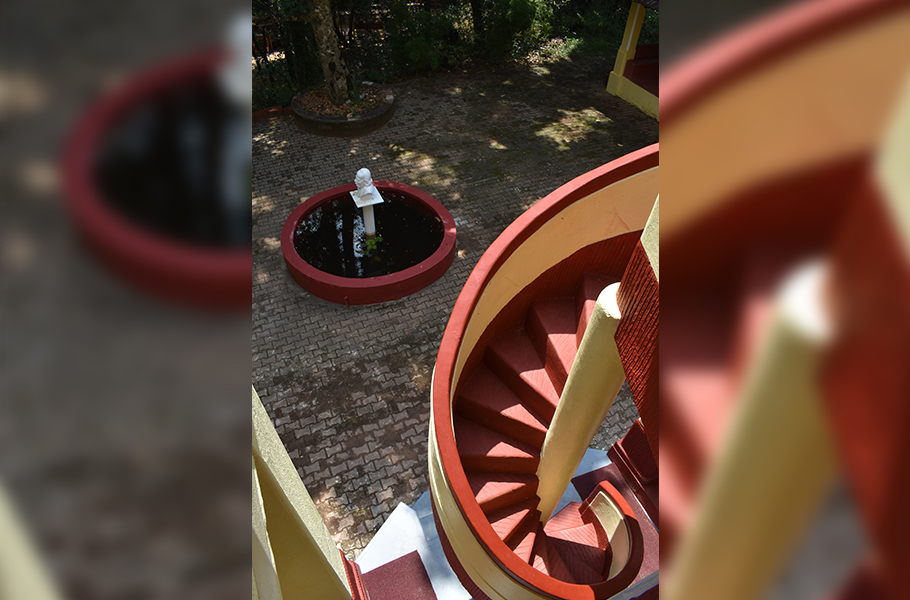
- Home
- News
- Analysis
- States
- Perspective
- Videos
- Education
- Entertainment
- Elections
- World Cup 2023
- Features
- Health
- Business
- Series
- Economy Series
- Earth Day
- Kashmir’s Frozen Turbulence
- India@75
- The legend of Ramjanmabhoomi
- Liberalisation@30
- How to tame a dragon
- Celebrating biodiversity
- Farm Matters
- 50 days of solitude
- Bringing Migrants Home
- Budget 2020
- Jharkhand Votes
- The Federal Investigates
- The Federal Impact
- Vanishing Sand
- Gandhi @ 150
- Andhra Today
- Field report
- Operation Gulmarg
- Pandemic @1 Mn in India
- The Federal Year-End
- The Zero Year
- Premium
- Science
- Brand studio
- Home
- NewsNews
- Analysis
- StatesStates
- PerspectivePerspective
- VideosVideos
- Entertainment
- ElectionsElections
- Sports
- Loading...
Sports - Features
- BusinessBusiness
- Premium
- Loading...
Premium

Restoring Shivaram Karanth’s legacy, one brick at a time

A quaint house in Karnataka’s Puttur town sat hidden in plain sight for decades – its walls crumbling bit by bit. Built by Jnanpith awardee Kota Shivaram Karanth in 1930, Balavana is spread over five acres of uneven terrain flanked by a verdant countryside in Dakshina Kannada district on the foothills of Western Ghats. The house that had seen many a tale spun under its wooden roof...
A quaint house in Karnataka’s Puttur town sat hidden in plain sight for decades – its walls crumbling bit by bit. Built by Jnanpith awardee Kota Shivaram Karanth in 1930, Balavana is spread over five acres of uneven terrain flanked by a verdant countryside in Dakshina Kannada district on the foothills of Western Ghats.
The house that had seen many a tale spun under its wooden roof was silently caving in as termites infested the wood and heavy monsoon rains led to seepages that made its walls wobbly over time.
It was in this very house that Karanth penned his Jnanpith winning book, Mookajjiya Kanasugalu. The house, however, fell into ruin after Karanth – described by historian Ramchandra Guha as Rabindranath Tagore of modern India – moved to Kota (Karnataka) in 1973.
For years, the house and its surrounding structures, also built by Karanth, silently endured neglect and the resulting dilapidation. In 1997, Balavana also absorbed the grief of the death of its owner in faraway Manipal. But sometime around the early 2000s, the people of the region and Karanth’s admirers beyond Puttur started a desperate bid to restore the house.
Karanth’s daughter Kshama Rau, her elder brother Ullal Karanth, their eldest sister Malavika, Karanth’s close friend Chiranjeevi Singh, former chief minister of Karnataka M Veerappa Moily and former vice-chancellor of Kannada University (Hampi) professor B Viveka Rai were part of the state committee which took forward the restoration process that started in 2005.

While there was a demand to do something about the house and the surrounding structures, the galvanising force came in the form of Dr Amrut Malla, a prominent citizen of Puttur and close associate of the Karanth family. Malla, along with Purandhar Bhat, president of Kannada Sangha of Puttur, which was incidentally started by Karanth himself, appealed to the Mangaluru deputy commissioner to protect Karanth’s legacy.
Soonafter, the Bengaluru chapter of the Indian National Trust for Art and Cultural Heritage (INTACH) expressed willingness to participate in the full restoration of the property. Support poured in from all directions, including former culture minister Umashree, who took keen interest in restoring the legacy property. Karanth’s family donated the land to the government to preserve his legacy.
And thus began the task to restore the property which is ultimately envisioned to have Karanth’s tiled house, a study room inspired by European architecture with an unusual spiral staircase, a Natyashala and a mini theatre.

“I am happy that Balavana’s fame will now grow beyond Karnataka, just like the monuments of Kuvempu at Kuppalli in Shivamogga district, Dattatreya Ramachandra Bendre in Hubballi and Rashtrakavi Govinda Pai at Manjeshwara in Kerala,” said Kshama Rau.
The importance of Balavana
In his lifetime, Karanth wrote 47 novels, 31 plays, 13 books on art, four short collections, six collections of essays and sketches, 12 books on children’s literature, six books on science, two autobiographies, four travelogues, two biographies and nine other books on culture, art and theatre. Many of these books were penned at the Balavana house in Puttur. These include Chomana Dudi, Balveye Belaku and award-winning plays such as Garbhagudi and Domingo, besides literary series such as Bala Prapancha, Vishwa Kosha and Kaliyuva Aata.
His contributions to the field of literature, Yakshagana (traditional theatre), art, cinema, environment and social movements make Balavana a natural abode of Karanth’s thoughts and learning. The thick natural forest that has sprung up all around Balavana was once nurtured by Karanth. A few fruit-bearing trees that include wild mangoes, jamuns, tamarinds, and amla among others attract many species of birds.
His patrons feel Puttur, 55 km from Mangaluru, was Karanth’s ‘Karma Bhoomi’ and it was here that he achieved greatness. “I would rate him much higher than the European masters as the range of his study encompassed the global attributes of the art forms. In many ways he is comparable to Gurudev Rabindranath Tagore,” former Karnataka chief minister M Veerappa Moily told The Federal.
“I happened to read an article in The Manchester Guardian that wrote about the Yakshagana ballets choreographed by Karanth during this Europe tour. The paper equated Karanth’s ballets with the musical renditions of [Pyotr Ilyich] Tchaikovsky on many counts, especially the coordination of dance-music and the interpretation,” Moily said.
The rebuilding: One step at a time
The first structure that was worked upon was the tiled house. By 2017, it was restored to its original glory. While teak replaced the ordinary wooden ceiling, the walls were rebuilt with lime and mortar. Old stones, tiles, rafters, door frames and windows that were intact were salvaged. Damaged items were replaced with new ones to give the house an original look even as the wiring in the house was encased in the walls.
While the state government granted Rs 29 lakh for the restoration of the house, another Rs 1 crore was sanctioned in the 2015 budget for other development works to be taken up in a phased manner. INTACH, along with Pankaj Modi, completed the work to restore the house in October 2016. Modi, an expert in restoration of heritage buildings, is known to have restored the building of the Institute of Oriental Studies in Mysuru, which houses the original manuscript of Kautilya’s Arthashastra.

Work was simultaneously underway to refurbish the study room. The project, however, has been suffering from the usual fund disbursements that underlies most government works.
A high-ranking official of the department of Kannada and culture said the process of releasing funds for the project has been expedited, but there are some complex procedures that have to be followed. According to him, the elaborate accounting system also plays a role in delaying the release of funds. “And since it pertains to a national laureate everything has to be perfect, including the repair work,” said the official who wished to remain unnamed.
There is another reason. The development of Karanth’s Balavana remains an ongoing process since the range of his work – from art, literature, folk culture to performing arts — is so vast that more research is needed to fully bring his work to light.
On Karanth’s 119th birth anniversary on October 10 this year, Puttur MLA Sanjeeva Matandoor inaugurated the restored reading room. This room, which is adjoining his house, was where Karanth wrote a good number of his literary works.
For Balavana, next on the cards is the restoration of the Natyashala, the last of the three structures that Karanth built himself. It is the Natyashala which will create a room for a mini theatre going ahead to showcase the work of Karanth. Together the four structures will serve as a tribute to Karanth and the work he has left behind.
But not everyone is happy with the way things have unfolded. Malla, who led the ‘Save Karanth House Movement’, is one of them. “They destroyed a thick forest area which had many fruit trees planted by Karanth. The forest was cleared to build a swimming pool inside Balavana. The swimming pool has nothing to do with the life of Karanth. The family and the core committee has already expressed a desire to shift the swimming pool from there. Instead, there should be a mini film theatre and a full-fledged library,” Malla told this correspondent.
Others upset with the developments told The Federal that even as the project was going on, there was a proposal to build a gymnasium as part of the heritage project. It took sustained efforts from locals and Karanth’s followers to get the authorities to junk the plan.
“Karanth was involved with almost all the academies including Janapada, Yakshagana Tulu, Chitrakala, Kannada Sahitya Parishat and many others. Even if these academies organise just three programmes every year at Karantha Balavana, its mandate will be fulfilled,” said Malla.

State minister of Kannada and culture Sunil Kumar also agrees. He said his ministry will initiate year-long cultural programmes that will reflect the thoughts of Karanth in Balavana. “Karanth’s Natyashala needs restoration. It is the last among the three buildings that Karanth built at Balavana. The local people have contributed greatly towards the development of Balavana.”
State committee member Chiranjeevi Singh, who has guided the cultural aspects of Balavana, has a bigger vision. “Balavana has the potential to acquire the same level of eminence and importance that Tolstoy’s Yasnaya Polyana in Russia and Shakespeare’s Stratford-upon-Avon have. You cannot cram everything in Bengaluru. Balavana should have already been a cultural centre on the coast,” said Singh.
That, he added, would have been a befitting tribute to Karanth.
(Author is a Mangalore-based senior journalist)

